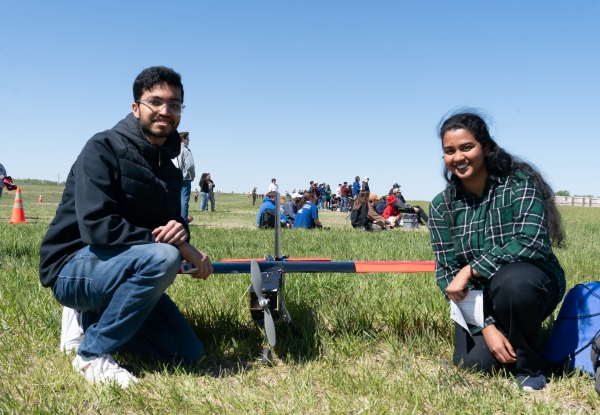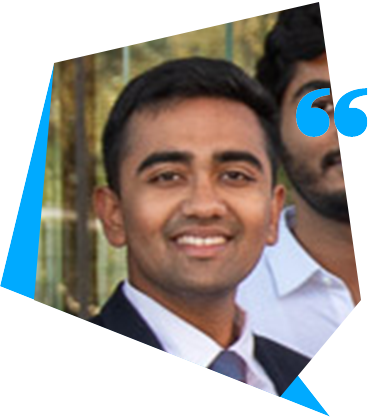< back to articles
The Section Drone team at Design Build Fly 2024
Published on
The ISAE-SUPAERO Drone Section team was supported in 2024 with a bursary to take part in the 28ᵉ edition of the Design, Build, Fly competition held from April 18 to 21, 2024 in Wichita, Kansas. An exceptional opportunity to compete against students from all over the world on the technical issue of aircraft creation.
Team representative Kathan Bhavsar tells us how the competition went.

Tell us about your experience at the Design, Build, Fly competition
The 28ᵉ annual AIAA Design/Build/Fly (DBF) competition, held April 18-21, 2024 at Textron Aviation Employees’ Flying Club, 10335 E Central, Wichita, Kansas, USA 67206, was a notable event that showcased the talents of university students in the field of aerospace engineering. The main objective of the competition was to design, build and test a radio-controlled aircraft capable of operating in urban air mobility scenarios.
Teams were tasked with creating an aircraft capable of efficiently performing a delivery flight, a medical transport operation and an urban cab flight, reflecting the potential real-world applications of these technologies. The competition emphasized adaptability, as participants had to quickly reconfigure their aircraft between different mission profiles, while respecting size constraints and demonstrating their ability to respond to urgent situations.
How did the event go?
Kathan Bhavsar

The event brought together 93 teams and over 1000 students from 12 countries, creating an intense competitive environment while fostering camaraderie and collaboration between participants. Despite the technical challenges and setbacks, our team used the experience as a learning opportunity, highlighting the importance of resilience, thorough testing and contingency planning in engineering.
The AIAA DBF 2024 competition not only tested participants’ technical skills, but also their ability to work together, innovate and push back the boundaries of what is possible in aerospace engineering. It was a testament to the team spirit and perseverance that can overcome obstacles and achieve excellence in aeronautical design.
What were your team’s ambitions?
Participating in the 2024 “Design, Build, Fly” competition was an exhilarating journey that pushed our team to new heights in aerospace engineering. The team had to design, build and demonstrate the flight capabilities of an electrically-powered radio-controlled aircraft capable of best meeting the specified mission profile. The aim was to achieve a balanced design with good in-flight handling qualities and practical, affordable construction, while demonstrating high vehicle performance.
Tasked with designing, building and testing a radio-controlled aircraft for urban air mobility (UAM), we found ourselves at the cutting edge of aviation innovation. At the heart of the competition was the challenge of urban air mobility, a rigorous test of adaptability and ingenuity within strict time constraints.
Our team was made up of 18 ISAE-SUPAERO students from the Master’s and Engineering programs. The competition gave us, as engineering students, real-life experience of aircraft design, giving us the opportunity to validate our analytical studies. Our aircraft was challenged to undertake a series of missions, starting with a delivery flight and moving seamlessly to a simulated critical medical transport operation. The latter task, which involved transporting emergency personnel and medical supplies, highlighted the aircraft’s ability to respond rapidly to urgent situations. Finally, the aircraft was put to the test in an urban cab scenario, where efficient passenger transport was paramount.
Our objectives for the competition: to produce an aircraft that can best simulate the different missions presented to us, to maximize the number of payloads/passengers saved by our aircraft, and to produce an aircraft whose design is best suited to such a scenario.
What did you learn from this real-life experience?
These challenges resonated deeply with our team, as they reflect the pressing demands of real-world aviation scenarios. The need for aircraft to integrate seamlessly into urban environments and adapt quickly to changing mission parameters reflects the evolving landscape of modern aviation. Balancing these constraints without compromising safety, efficiency and performance has been a multi-faceted engineering puzzle that has fueled our team’s passion and determination. In meeting these challenges, we have honed not only our technical skills, but also our collaborative spirit and problem-solving skills.
Our participation in the competition was a collaborative effort, with each team member bringing unique skills and expertise to the table. We embraced the iterative nature of the design process, continually refining our design through simulations, prototypes and testing. This iterative approach has enabled us to identify and correct weaknesses, resulting in a more robust and efficient aircraft. Each hurdle we overcome is a testament to our team’s resilience and capacity for innovation, and reaffirms our commitment to pushing the boundaries of aerospace engineering.
Taking part in the “Design, Build, Fly” competition was more than just a test of our skills, it was an immersive journey of exploration, discovery and growth. It enabled us to showcase our talents on the international stage, and reinforced our belief that teamwork, ingenuity and perseverance can transform the future of aviation. The competition allowed us to apply theoretical knowledge to real-life engineering challenges. We tackled various aspects of aircraft design, including aerodynamics, structures, propulsion and controls, while taking into account factors such as weight, balance and manufacturability. Throughout the competition, our team dedicated countless hours to thinking, designing and building our aircraft, with the aim of optimizing its performance and efficiency.
What kind of difficulties did you face?
Despite our meticulous preparation and dedication, our participation in the “Design, Build, Fly” competition was marked by unforeseen challenges. Despite meticulous preparation, we encountered avionics technical failures on all three of our flight attempts. These failures, while disappointing, have taught us valuable lessons about resilience and adaptability. Each failure identified weaknesses in our design and execution, prompting us to reassess our approach and make the necessary improvements. While the experience was undoubtedly frustrating, it also highlighted the unpredictable nature of real-life engineering challenges. Despite our best efforts, factors beyond our control can sometimes derail the best-laid plans.
We ranked number 4ᵉ in Europe and 76ᵉ worldwide out of 110 teams, 62ᵉ in ground missions and 75ᵉ in design report rankings. Out of 110 teams, only 85 passed technical inspection and 65 had at least one attempted theft, including us. However, rather than succumb to defeat, we chose to see these failures as part of the learning process. They reinforced the importance of thorough testing and contingency planning, encouraging us to hone our skills and strategies for future projects. In the face of adversity, our team has remained true to its commitment to innovation and excellence.
According to the ground mission judges, our aircraft stood out as one of the most compact models in parked configuration at the competition. In the end, we emerged from the competition with a renewed determination to overcome obstacles and continue pushing the boundaries of aerospace engineering.
So you returned home with a very positive assessment of the experience?
One of the most rewarding aspects of the Design, Build, Fly competition was the opportunity to interact with teams from all over the world. Despite the intensity of the competition, a spirit of camaraderie and collaboration prevailed among us participants. Interacting with other teams allowed us to discover different approaches to aircraft design and problem-solving strategies. Another important point to mention is that teams like ours, who didn’t have a pilot with them, were able to obtain one during the competition. Our pilot was a student from the University of Buffalo, who was also a certified pilot. This mutual aid shows that the aim of the competition was to help each team fly in the competition. What’s more, the team from the Massachusetts Institute of Technology also helped us with an electronic component that we couldn’t find anywhere near the competition site, demonstrating the helpful nature of the competition.
Representing France at an international event as part of a diverse team was a particularly rewarding experience. Although we were less numerous than participants from other regions, our presence underlined France’s commitment to innovation and excellence in aerospace engineering. As one of the few European teams, we feel a sense of pride in showcasing the ingenuity and expertise our country has to offer. Our participation not only represented our team, it also testified to France’s rich heritage of aerospace innovation. Working alongside teams from different cultural backgrounds gave us the opportunity to exchange ideas, learn from different points of view and forge international links.
Moreover, competition itself has instilled in us a sense of responsibility to maintain the standards of excellence associated with our country’s aerospace industry. We met each challenge with determination and steadfastness, knowing that we carried with us the hopes and aspirations of our country. While the competition may have been intense, our experience was characterized by camaraderie, mutual respect and a shared passion for aerospace innovation. Our presence was a reminder that innovation knows no borders, and that collaboration between nations is essential to push back the frontiers of aerospace engineering.
In conclusion
Our participation in this international event not only provided us with a platform to demonstrate our skills and expertise, but also instilled in us a deep sense of pride in representing ISAE-SUPAERO and France on the world stage. It was an unforgettable experience that underlined our commitment to pushing back the boundaries of aerospace innovation while fostering international cooperation and understanding.
This experience was decisive in our careers as aerospace engineers. This renowned competition challenged our team to design, build and demonstrate the flight capabilities of an unmanned aircraft. Through hands-on work and collaboration, we gained practical skills and innovative ideas.
The dynamic nature of the competition kept us on our toes, encouraging adaptability and creativity. Interaction with our peers and industry experts broadened our network and provided valuable feedback. The competition served as a catalyst for personal and professional development. Taking on challenges, pushing boundaries and seeing the tangible results of our efforts gave us a sense of confidence and achievement.
The skills and experiences acquired during this trip will undoubtedly form a solid foundation for our future projects in the aerospace industry. All in all, this competition has enabled us to acquire skills and contacts that are vital to our future success in the aerospace industry.
A word to our donors?
Your generous support was instrumental in enabling our team to compete on the world stage. The funding provided by the Foundation not only enabled us to compete, but also strengthened our confidence and determination to excel. We are deeply grateful for the confidence the Foundation has shown in our project.
Your generosity has had a significant impact on our journey to redefine the boundaries of flight and advance the field of model aviation. Your support has enabled us to pursue our passion for innovation and engineering excellence, and we are truly determined to make the most of this opportunity.
Thanks to your support, we have been able to represent ISAE-SUPAERO with pride and distinction on the world stage. Thank you for investing in our dreams and playing a key role in our success.